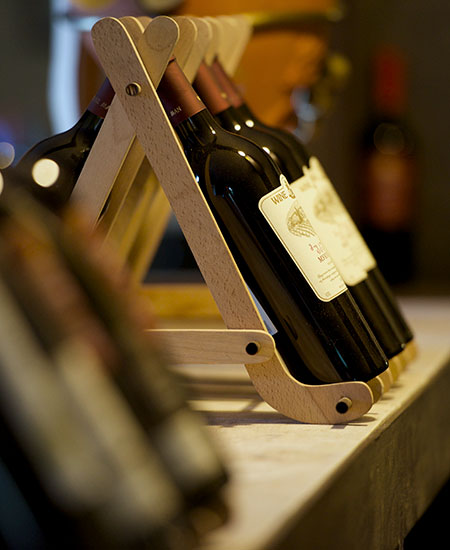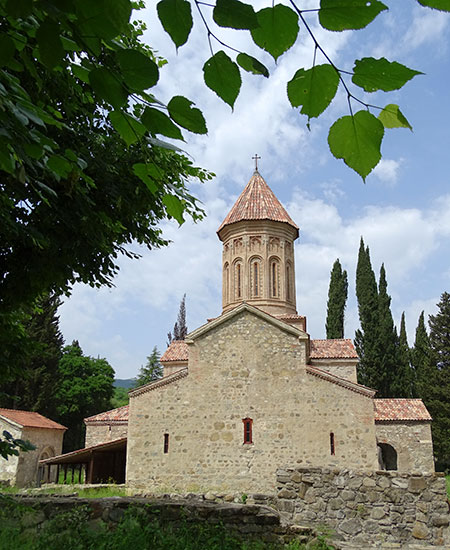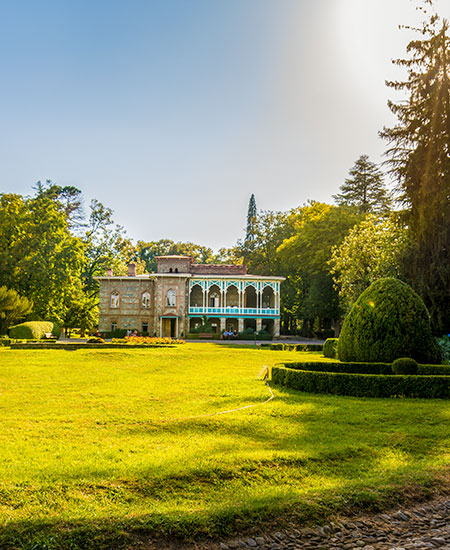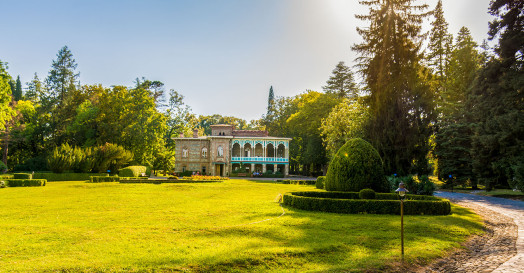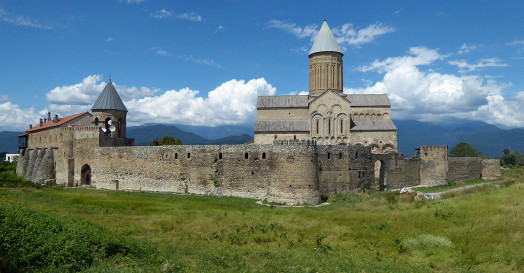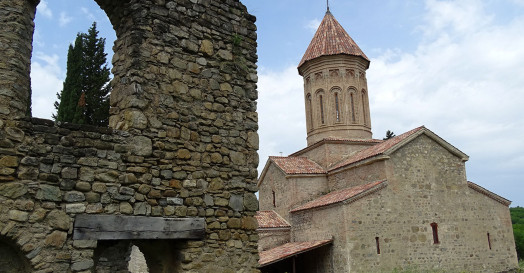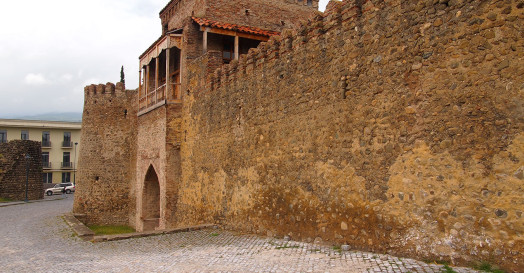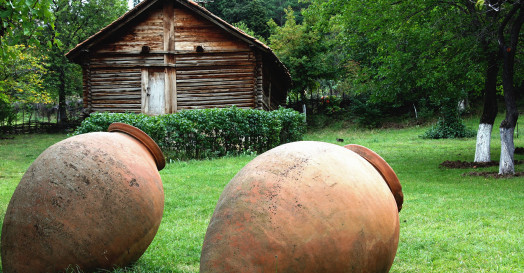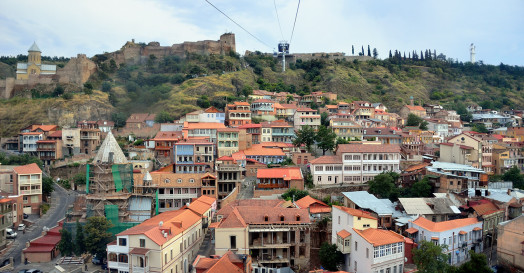1st Day → Tbilisi (Holy Trinity cathedral, Metekhi Church, The bridge of peace, Narikhala Fortress, Abanotubani, Funicular)
After a leisurely breakfast, we will start a sightseeing and walking tour of Tbilisi, a charming town built in the 5th century along the twisting valley of the Mtkvari River. All the places of interest are very close to one another, within just a few minutes walking distance.
We will start our tour from the Sameba Cathedral, also known as the Holy Trinity Cathedral in Tbilisi, which towers over the city and can be seen from almost any point. You might assume that it is an old building, however, it was constructed between 1995 and 2004, in the classic style. It’s opening marked 2000 years of Christianity and 1500 years of the independence of the Georgian Church.
Afterwards a car will take us up to Shavteli Street where our walking tour of Old Tbilisi will begin. First, we will view the bizarre tower of Gabriadze Theatre, where every hour an angel appears at the small balcony at the top and rings the bell. Cafe Gabriadze is an extremely lovely and well-decorated place. Right next to the Gabriadze place you will see the oldest basilica in Tbilisi, Anchiskhati. It was built in the VIth century, then partially damaged and restored, remaining undestroyed until now.
The next stop on the tour will be the Bridge of Peace, a massive glass bridge spanning the Mtakvari River. You can also see the presidential palace constructed in this era, perched on one of the cliffs over the river. Next, we will be crossing the bridge and will take a walk in Rike Park, where the cable car station is located. From here, we will take a cable car up to Narikala Fortress, which used to be a part of Tbilisi's fortification system from the VIth century. we will also visit the 13th century Metekhi church, with the equestrian statue of the city’s royal founder standing above the steep cliffs of the Mtkvari River.
Once at the top of the hill, we will take a walk to Mother of Georgia, who is welcoming guests with a bowl of wine and warns the enemies with her sword. We will also stroll along the forts, go inside and find another church there. Enjoy the view over Tbilisi - this is just the first point for today!
From the hill we will go down on foot. It is a bit steep, but nice. Will will see another corner of Old Tbilisi on our way. At the foot of the hill, we will find ourselves in Abanotubani, the so-called bath district of Tbilisi. The city started here - according to legend. Nearby the bath district we can find a little waterfall which is definitely worth a visit.
During the tour you will have a chance to buy presents and souvenirs. Right underneath Meidan Square in the heart of the touristic center of Tbilisi we will get to the Meidan Bazaar. It is an underground tunnel at Gorgasali Square in the Kala District that is lined with shops, selling all sorts of souvenirs and local products including wine, spices, tea, jam and sauces. You’ll even find postcards, handcrafted socks and other special items.
2nd Day → Mtskheta (the old capital of Georgia) - Jvari Monastery, Svetitskhoveli Cathedral, Cave town Uplistsikhe,Town Gori (Museum Joseph Stalin)
In the morning we visit Uplistsikhe cave town - one of the oldest-inhabited places in the Caucasus, which were founded in the Bronze Age . The first mention of Uplistsikhe occurs even in the annals of Ist century BC.. History of the town was full and ambiguous - it has experienced several ups and downs and finally was abandoned in the XIXth century. The city is known for its unique rooms and tunnels. After the adoption of Christianity in Georgia, several churches were built. For centuries, it served as the royal center and commercial crossroads of Kartli. After Uplistsikhe Cave town, on the way back it is possible also to visit the museum of Stalin in Town Gori (the place where Joseph Stalin was born)
After the caves, we will visit the ancient capital of Georgia Mtskheta, on the wat back to Tbilisi. Situated at the confluence of the Aragvi and the Mtkvari rivers, Mtskheta is the site of the first Christian churches in Georgia. We will first visit Jvari Monastery (6th century), located at the top of the hill. This is the place where the missionary St. Nino erected a cross (“Jvari” in Georgian) in the 4th century to mark the coming of Christianity to Georgia. We will visit the 11th century Svetitskhoveli Cathedral, used for centuries for the coronation and burial of Georgian monarchs. Most importantly, it is considered one of the holiest places in Georgia, since the Robe of Christ is buried here. Svetitskhoveli is one of the most beautiful cathedrals in Georgia, with exquisite carvings and frescoes.
3rd Day → Kakheti - Ancient academy and Monastery of Ikalto, Alaverdi cathedral, Telavi (Castel of the Lord), Tsinandali - Manor of the great Georgian family.
After checkout from the hotel, we will go to Kakheti-the wine region of Georgia. First we will visit Ancient academy and Monastery of Ikalto.
The monastic complex of Ikalto is situated 7-8 kilometers west of Telavi on the outskirts the village of Ikalto. The complex was founded by one of the Assyrian monks – Zenon of Ikalto in the late VI century.
Ancient academy of Ikalto is famous for the fact that Shota Rustaveli, the outstanding Georgian poet of the 12th century, used to study there. The academy is a part of St. Xenon monastic complex, located 8 km from Telavi.
Besides Ikalto the monastic complex, founded by St.Xenon of Ikalto, includes small churches Sameba (the 6th century), Perisuvaleba (the 8th – 9th centuries), Khvitmshobeli (the 9th century). All of them were restored in the 19th century. One of the churches keeps the hallows of St. Xenon of Ikalto. The academy building is the newest (the 12th century). Today only the fragments of it can be seen on the roadside hill. The building of the academy was not restored its destruction by the hordes of Shah Abbas I in 1616. The academy, built by David the Builder, had been one of the important cultural and educational centers of Georgia.
Next destination is Alaverdi Cathedral. Kakheti shrine is located 20km from Telavi. It is one of the most well-known medieval temples in Georgia – Alaverdi cathedral (located in the settlement with the same name). It was built in the beginning of the 11th century and was one of the tallest structures of the time. The temple was built on the site of a small church of St. George . The temple is still called St. George Cathedral (Tsminda Georgi).
After Alaverdi Cathedral we will go to visit Telavi-the main town of the region of Kakheti. The capital of Kakhetian winery
Telavi is located in the heart of Kakheti, the historical area of eastern Georgia, in the valleys of the rivers Iori and Alazani. A trip to Telavi is an excursion around a surprisingly beautiful region to the world of ancient temples and monasteries, picturesque rivers and valleys where amber grapes grow under the warm sun rays. Telavi is not only the region centre. It is the centre of Georgian winemaking which is a cult there.
Telavi is located in the most beautiful Alazani valley on the slope of Tsivi-Gombor ridge. The city is situated at 490 m above the sea level so the air there is fresh and pure. The landscapes of Telavi and its vicinities are very impressive. You will enjoy the green river valleys, the slopes of the mountains of the Major Caucasus with its peaks and wood-grown slopes and Alpine meadows. Winters in Kakheti are cold; summers are dry and hot.
Our last destination will be Tsinandali, which is located nearby Telavi, it is only 10 minutes to drive from Telavi. Tsinandali-Manor of the great Georgian family
A manor in the village of Tsinandali is an ancestral estate, a palace of the princely family of Chavchavadze. There are many amazing, beautiful and tragic events in the history of Georgia are connected with him.
The father of Alexander Chavchavadze, the first owner of the manor – Garsevan Chavchavadze, was one of the initiators of annexation of Georgia to Russia; Treaty of Georgievsk has his signature. He participated in the war with Napoleon in campaign to Europe in 1812, 1813, and 1814. He conquered Paris and achieved the rank of general-lieutenant. After, tired from the military campaigns, Alexander Chavchavadze decided to leave the capital. He took his family from Saint-Petersburg and moved to a quiet village of Tsinandali where he started his project on the Europeanization of Georgia.
The manor in Tsinandali is the reflection of his aspirations. He hadn't only applied European architectural techniques in the construction and inner planning, he laid out an English garden around his palace.
Moreover, there were not only trees, but also gardeners who came from the Great Britain. He did not stop on this. Chavchavadze invited the best winemakers from Europe, with whom he built the first wine factory that produces wines according to European technologies. Thus appeared popular in present “Tsinandali” wine.
4th Day → Sighnaghi - the city of wine and love, Bodbe Monastery, Kvareli winery.
We will start the tour in the morning from Tbilisi, and move to our main point Sighnaghi. When we reach the city we can look over the fence for unmatched views of the town and its surroundings. We will be walking along the cobblestone paths and see more than 20 towers and six stone gates that remain of the original fortification. We will walk along with various buildings, traditional Georgian houses, Churches & bell tower. We will also stop at some wineries, where we will taste red and white wines, made in traditional Georgian style and Georgian spirit called Chacha and you will have the opportunity to buy some local products made with different kinds of fruits. We can also visit the Georgian National Museum, which was founded in 1947. The first exhibition opened on December 31, 1950, comprising seven hundred artifacts.
Then we will move to Bodbe Monastery (built in the 9th century) of Saint Nino (the saint, who preached Christianity in Georgia). Here is the grave of Saint Nino and her holy spring - the sites visited by believers from all over the world, where you can also have a bath.



